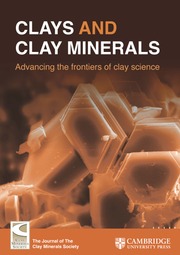Article contents
Preparation and Properties of Sepiolite-Based 3D Flame-Retardant Aerogel
Published online by Cambridge University Press: 01 January 2024
Abstract
Sepiolite-based composites have great potential for application as flame-retardant and thermal-insulation material but their application and development are limited by poor mechanical properties. The objective of the present study was to combine polyvinyl alcohol (PVA) and 3-aminopropyltriethoxysilane (KH-550) with sepiolite (Sep) to improve its aerogel strength. A universal testing machine, thermogravimetry, and microcalorimetry were used to investigate the mechanical properties, thermal-stability, and flame-retardant properties, respectively, of aerogels. The results indicated that KH-550 can enhance effectively the mechanical properties and flame retardancy of aerogels. The compressive modulus of PVA/Sep vs KH-550/PVA/Sep aerogel was 209.28 vs. 474.43 kPa, the LOI index changed from 26.4 to 30.4%. The porosity of the aerogels was > 96% and the density was < 0.05 g/cm3. The thermal conductivity remained at between 0.0340 and 0.0390 W/(m·K), and the aerogel could recover to > 85% after a 50% compressive deformation. These data indicated that Sep-based aerogel would act as a flame retardant and a thermal insulating material with excellent mechanical properties.
Information
- Type
- Original Paper
- Information
- Copyright
- Copyright © The Author(s), under exclusive licence to The Clay Minerals Society 2023
References
- 3
- Cited by

